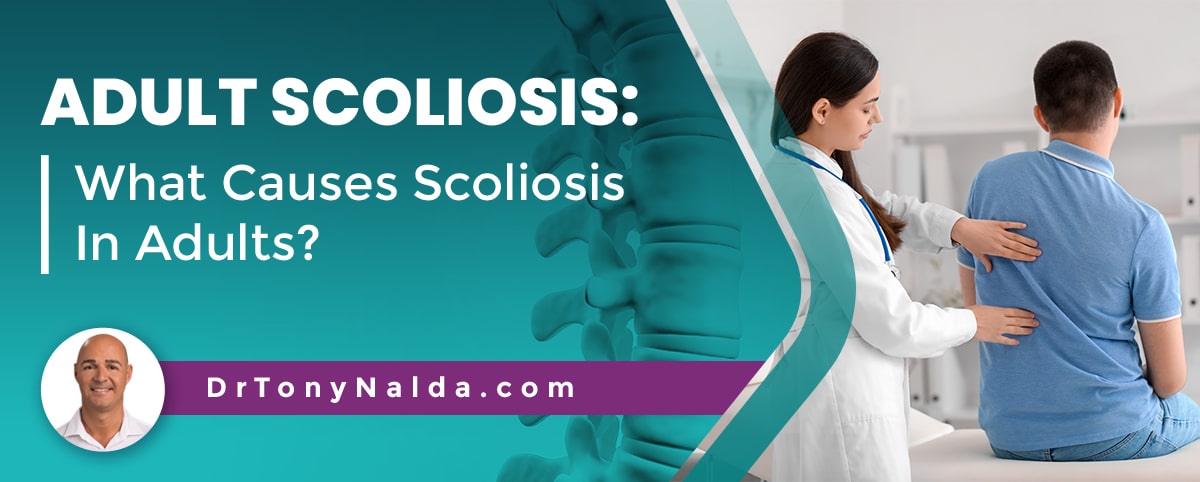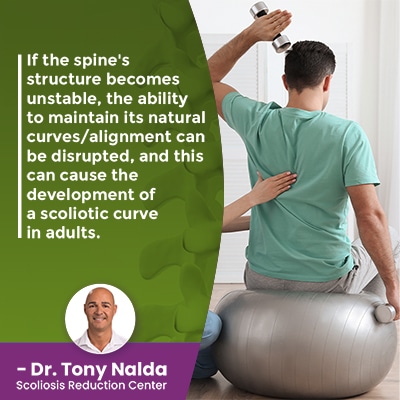Adult Scoliosis: What Causes Scoliosis In Adults?

While many consider scoliosis a childhood condition, the actual rate of scoliosis increases with age. Continue reading to learn about the types of scoliosis that affect adults and why adult scoliosis tends to be more painful than childhood scoliosis.
The two main types of scoliosis to affect adults are idiopathic and degenerative. Cases of adult idiopathic scoliosis involve adolescents who were neither diagnosed nor treated during adolescence, and degenerative scoliosis affects older adults as it's caused by natural age-related spinal degeneration.
Let's start our discussion of adult scoliosis by first exploring why patient age is such an important variable.
Table of Contents
Classifying Scoliosis
Classifying scoliosis based on key patient/condition variables is an important part of the diagnostic process. Scoliosis is classified based on patient age, condition type, severity, and curvature location.
Classifying scoliosis not only helps streamline the treatment process, but also informs the customization and crafting of potentially-effective treatment plans.
Scoliosis involves the development of an unnatural side-to-side curve of the spine, and it also rotates, meaning it twists, and this rotational component makes scoliosis a complex 3-dimensional condition.
A spinal imbalance is a serious thing as it introduces a lot of uneven forces to the spine, its surrounding muscles and nerves, and the entire body as its center of gravity is disrupted.
Patient age is an important variable because it affects one of the condition's defining features: its progressive nature, and it also helps determine whether or not a patient's scoliosis is likely to be painful.
Patient Age and Progression
Scoliosis is a progressive condition, meaning its nature is to get worse over time, and this means the size of the unnatural spinal deformity is increasing, as are the condition's uneven forces, and their effects.
While we don't always know what triggers the initial onset of what's called idiopathic scoliosis, we do understand what triggers its progression: growth and development.
So in my adult patients who have reached skeletal maturity and have no more growth to go through, I know that progression is unlikely to be as rapid and that there is more time for treatment, while the focus when treating adolescents is achieving a curvature reduction and holding it there despite the constant trigger of growth.
In patients who are still growing, counteracting the trigger for progression is how proactive treatment works: working towards preventing progression.
While progression still occurs in adult scoliosis, particularly once age-related spinal degeneration comes into effect, patient age does indicate how much of a focus monitoring for, and counteracting, progression is necessary.
Patient Age and Pain
 Another important condition factor related to patient age is how painful a person's scoliosis is, and whether or not pain relief is going to be a facet of treatment.
Another important condition factor related to patient age is how painful a person's scoliosis is, and whether or not pain relief is going to be a facet of treatment.
Adult scoliosis diagnosed is generally because of pain. While postural deviation is the main symptom of scoliosis in children, in adults, it's pain that brings the majority of them in to see me for a diagnosis and treatment.
When the spine is still growing, prior to skeletal maturity being reached, it's experiencing a constant lengthening motion that counteracts the compressive force of the unnatural spinal curve, and it's compression of the spine and its surrounding muscles and nerves that causes the majority of condition-related pain.
So in children, back pain and pain caused by nerve compression aren't common issues, so don't generally have to be a focus of treatment, but in adult scoliosis, they are a focus of treatment as the most noticeable experienced scoliosis symptom.
As scoliosis doesn't become a compressive condition until skeletal maturity has been reached, scoliosis pain is experienced very differently by children and adults.
Now that we've addressed how progression and pain differ in adult scoliosis, let's talk about the two main types of scoliosis to affect adults: idiopathic scoliosis and degenerative scoliosis.
Idiopathic Scoliosis in Adults
The most-prevalent type of scoliosis overall is idiopathic scoliosis, and the most common age affected are adolescents between the ages of 10 and 18 as adolescent idiopathic scoliosis.
Now, in cases of adolescent idiopathic scoliosis, early detection isn't always easy to achieve; remember, as scoliosis pain isn't generally a noticeable symptom in children, it can easily go unnoticed, particularly when mild.
Mild scoliosis isn't associated with functional deficits, isn't generally painful in children, and even the postural changes it causes can be subtle at this level.
Scoliosis ranges widely in severity from mild to moderate and severe to very severe, and while it's highly beneficial to diagnose scoliosis while mild, when it's going to be the simplest to treat, most patients are diagnosed after they've progressed from mild to moderate, when condition indicators tend to become more noticeable.
In fact, so many cases of adolescent idiopathic scoliosis go undiagnosed that idiopathic scoliosis diagnosed in adults are cases of adolescents who had scoliosis while young but were unaware; now, their scoliosis has progressed with time and maturity, and once skeletal maturity is reached, the condition becomes painful, leading to a diagnosis and treatment in adulthood.
The unfortunate reality is that had these adult patients received a diagnosis and treatment during adolescence, their spines would be in far better shape than by the time they come to see me, but regardless of patient age or severity, the best time to start scoliosis treatment is always now.
So what causes scoliosis in adults that develops fresh in adulthood?
Degenerative Scoliosis
 After idiopathic scoliosis, degenerative scoliosis is the next most common type to affect adults, and this affects older adults (50+) as it's most commonly caused by natural age-related spinal degeneration.
After idiopathic scoliosis, degenerative scoliosis is the next most common type to affect adults, and this affects older adults (50+) as it's most commonly caused by natural age-related spinal degeneration.
Also known as de novo scoliosis, unlike idiopathic scoliosis in adults, degenerative scoliosis develops fresh in adulthood with no prior history.
Women are also more likely to be diagnosed with degenerative scoliosis than men due to changes in hormone levels and bone density related to menopause.
The cumulative effect of certain lifestyle factors also can affect a person's rate and severity of age-related spinal degeneration: carrying excess weight, leading a sedentary lifestyle, excessive smoking and/or alcohol consumption, chronic poor posture, and repeatedly lifting heavy objects incorrectly.
When it comes to spinal degenerative changes, it's most often the spinal discs that are the first structures to feel the effects of deterioration.
The spine consists of vertebrae (bones) stacked on top of one another and forming three main spinal sections: the cervical spine (neck), thoracic spine (middle/upper back), and the lumbar spine (lower back).
Adjacent vertebrae are separated by an intervertebral disc, and the discs give the spine structure (adjacent vertebrae attach to the disc in between), provide cushioning so friction isn't generated during movement, combine forces to facilitate spinal flexibility, and act as the spine's shock absorbers.
Once a disc starts to degenerate, it can become desiccated and change its shape as a result, and this shift can disrupt the spine's function and affect it in a number of ways, one of which is by disrupting the position of adjacent vertebrae that are attached to a deteriorating disc.
If the spine's structure becomes unstable, its ability to maintain its natural curves/alignment can be disrupted, and this can cause the development of a scoliotic curve in adults.
Conclusion
So what causes scoliosis in adults? The two most common causes are idiopathic scoliosis that's undiagnosed during adolescence and natural age-related spinal degeneration.
What's interesting is that although scoliosis is most commonly diagnosed in children, the actual rate of scoliosis increases with age, and this is because age-related spinal degeneration increases the development of scoliosis as the population ages.
In addition to ranging widely in severity from mild to very severe, there are also different types of scoliosis, the most common of which is idiopathic scoliosis, accounting for approximately 80 percent of known diagnosed cases, and the remaining 20 percent are associated with known causes: neuromuscular scoliosis, degenerative scoliosis, and congenital scoliosis.
When it comes to treating scoliosis in adults, here at the Scoliosis Reduction Center, I apply a conservative chiropractic-centered non-surgical treatment approach because I feel this is what gives patients the best possible quality of life throughout treatment and beyond.
I integrate multiple condition-specific types of treatment so conditions can be impacted on every level: chiropractic care, physical therapy, corrective bracing, and rehabilitation.
When it comes to pain relief, the most sustainable long-term remedy for scoliosis pain is proactive treatment that addresses the underlying structural nature of the unnatural curvature of the spine.
When the spine curves unnaturally, it can compress the spinal canal through which the spinal cord passes, and this can cause a pinched nerve and nerve damage.
When treated proactively, a curvature reduction can be worked towards, and core strength can be increased so the spine is optimally supported/stabilized by its surrounding muscles, and a focus in treating scoliosis that affects older adults is reducing a scoliotic curve back to where it was prior to becoming painful.
When scoliosis is addressed proactively, the spine's function and strength can be preserved, while the need for invasive surgical treatment can be avoided.
Dr. Tony Nalda
DOCTOR OF CHIROPRACTIC
After receiving an undergraduate degree in psychology and his Doctorate of Chiropractic from Life University, Dr. Nalda settled in Celebration, Florida and proceeded to build one of Central Florida’s most successful chiropractic clinics.
His experience with patients suffering from scoliosis, and the confusion and frustration they faced, led him to seek a specialty in scoliosis care. In 2006 he completed his Intensive Care Certification from CLEAR Institute, a leading scoliosis educational and certification center.
About Dr. Tony Nalda
 Ready to explore scoliosis treatment? Contact Us Now
Ready to explore scoliosis treatment? Contact Us Now





